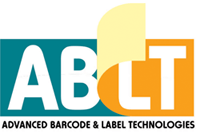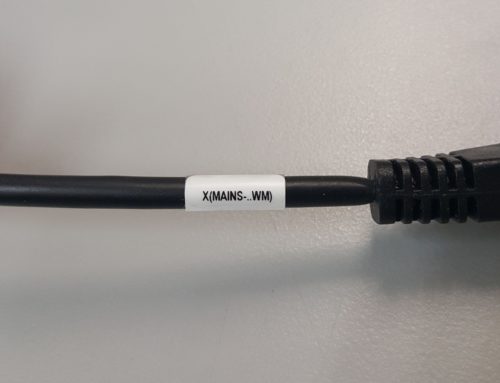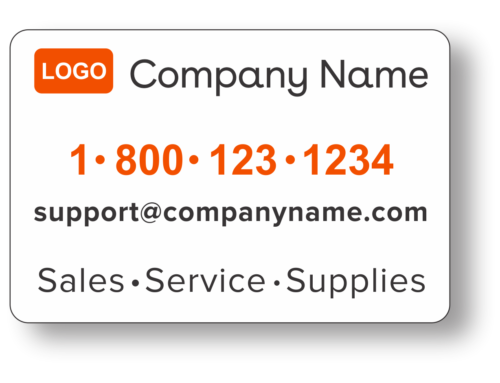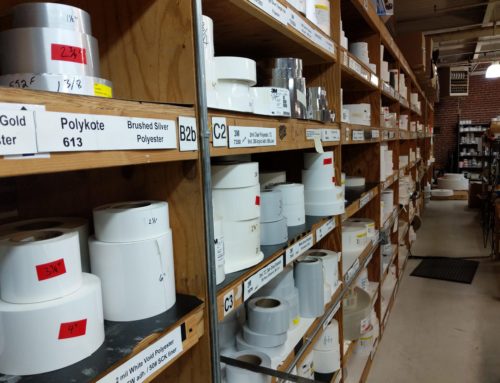 There are many, many types of labels out there but do you know what asset labels are?
There are many, many types of labels out there but do you know what asset labels are?
How do asset labels differ from other labels? Are they unique to an industry? What information do they present?
Well, to answer your question, asset labels are used to identify maintenance and operational purposes. They are most commonly found in industrial and military industries. Often made of Traffolyte, they are tamper-proof, permanent and frangible. Asset labels usually come with some sort of barcode for electronic reading as well.
Asset Labels Have Many Uses
Asset labels, and the process of asset labeling, covers a huge range of identification and they are often found on everything from office furniture and equipment to tools, computers, and electronic fixtures. Any time you see a label on a computer with a barcode, or a label on a fire extinguisher, you are seeing an asset label. In some ways, asset labels are one of the most common labels that can be found out there today. In any given day, you probably come across at least one without even realizing it.
Without asset labels, proper repair maintenance service would be nearly impossible. It would be hard for anyone to know the last time something was serviced if there was no asset label on the product.
Where you find asset labels:
There are two main types of assets you will find an asset label on.
- Moveable asset: This is anything that is not part of infrastructure or a building. Computers, especially laptops, are considered to be moveable assets because they can have many different owners over the course of their life. Asset labels in this category are used for inventory control, equipment assignments, and loss prevention.
- Fixed assets: This type of asset is one that is part of a physical property and not going to be moved throughout its lifespan. This can include road signs, tunnels, water systems, sewer systems, dams, lighting systems, building equipment, and more. Asset labels in this case help to identify the company’s assets for project planning and analysis. Fixed asset labels also help to track maintenance, as has already been mentioned.
Long-term label solution
Asset labels are designed to be highly durable and long-lasting. They use special adhesives to prevent the label from being removed easily, and if the label is removed, it can clearly be seen as having been tampered with. This is what it makes it ideal for industrial use and use as a maintenance record.
Asset labels are also designed so that they can withstand conditions that are considered mild by some, as well as extreme. They can be designed so that they are resistant to abrasion, moisture, chemicals, solvent, UV radiation, high temperatures, low temperatures, uneven finishes, and outdoor exposures.
The asset label can also be designed so that it will adhere to a variety of surfaces, including metal, plastic, wood, painted, dirty, greasy, and oily surfaces.
The material for asset labels can vary as well, with options like plastic and tough polyesters being available. This is what helps the asset label be much stronger, and stand up to more abuse over the course of time. Many of the products that have an asset label on them are meant to last for years, and that means the asset label needs to stay on the product for that entire time.
Computer asset labels can often hold the serial number of the computer, information that may be needed many years down the road. This is why they need to be so durable. Premium polyester asset labels are a good choice for office settings for furniture, computers, and equipment.
They have a laminate over the label information, helping to prevent mild scuffing and chemicals from damaging the label. They also have a permanent adhesive on the back to prevent the label from being removed at any time over the course of its entire life.
The most widely used asset label is the foil asset label. It is the perfect option for tracking a variety of assets. They are made of anodized aluminum, but are flexible enough that they can be applied to a variety of services. With foil asset labels, the graphics of the label are under the surface of the label, providing the perfect barrier to a wide variety of environmental hazards.
If you need a label that is not going to be tampered with, you can get tamper-evident polyester asset labels, which have the word VOID left behind on the surface of the asset and the back of the label. The destructible vinyl asset labels are impossible to take off in one piece, giving a clear indication that the label was tampered with.
Barcodes on asset labels
Most commonly on an asset label, you are going to find barcodes. This essentially makes the asset label the “licence plate” of the device, equipment, or product. The barcode on the asset label is essential and allows for the ability to track the product, ring it through for sales, and monitor it for inventory. Asset labels and barcodes typically go hand-in-hand in most industry sectors.
Barcodes provide error-free and machine-readable solutions that eliminate the issues with manual transcription errors caused by humans. For cases when inventory is vitally important, having barcode asset labels is the perfect solution for any company.
Asset labels are customizable
One wonderful thing about asset labels is that they are highly customizable. They can come in many different colors, styles, and can even feature graphics like a company logo. They can be printed as single logos or in sets that are any size or shape.
If you are looking for a highly versatile solution for your labeling issues, you can’t go wrong with asset labels. Made in many different varieties, it will allow you to be able to keep track of equipment, track sales, and much more. Coming with the ability to prevent tampering, and to stand the test of time, they are the most versatile form of label that you can get on the market today. That is why they are so popular.
Need a quote? Have questions about asset labels?
Talk to a label expert at 800-321-3653 or 404-671-3150
Or submit your specifications HERE








